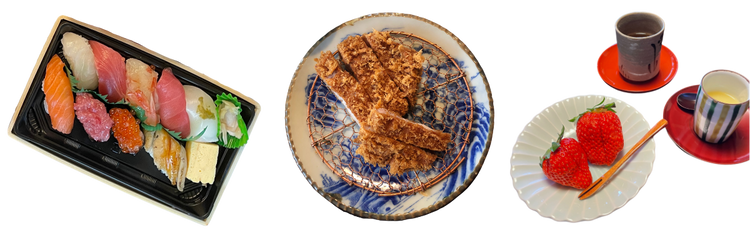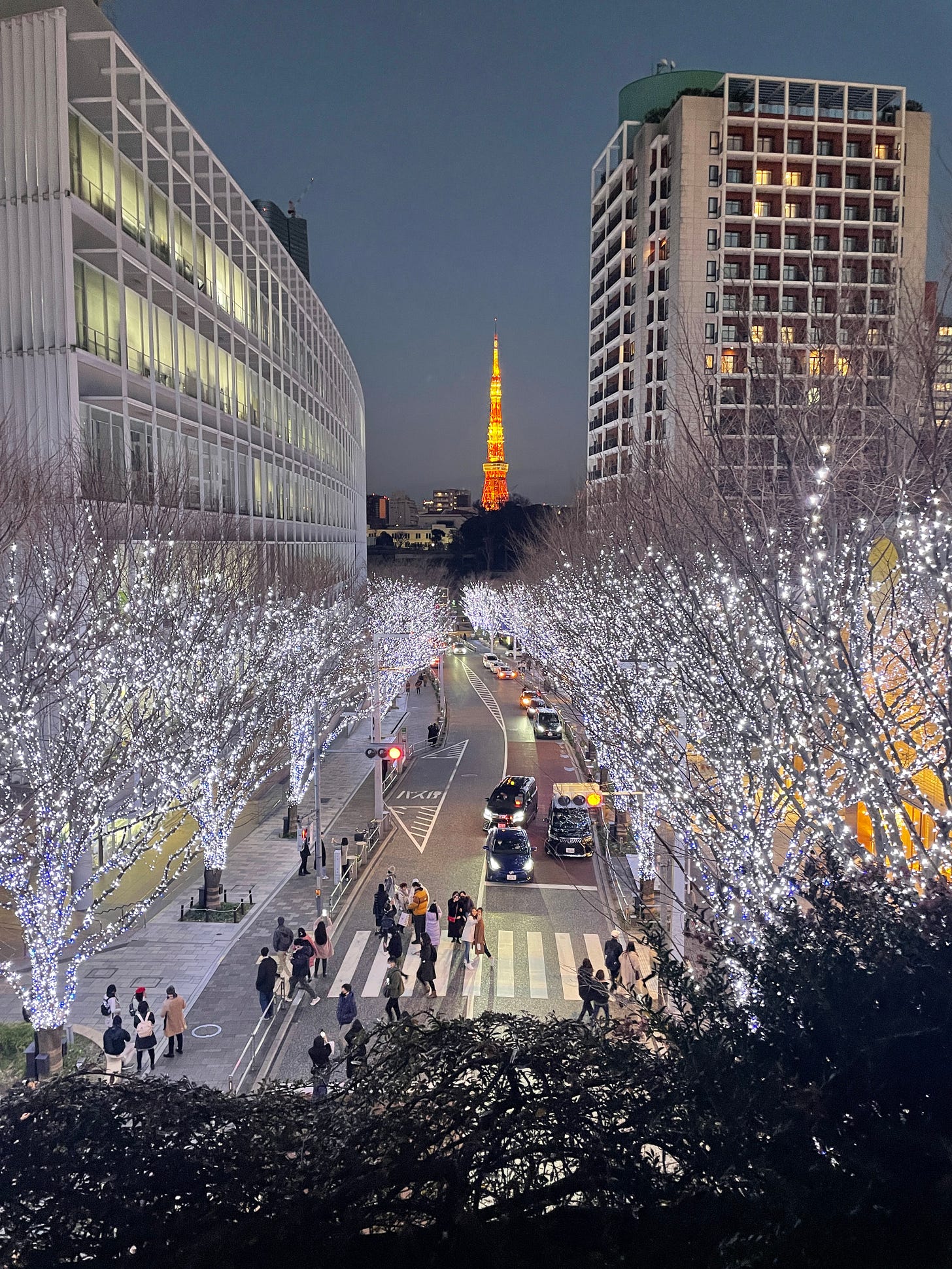It’s probably because they are. We just did. Should you…?
When doing some last minute noodling (on December 21) over where to go (on December 23 :), we originally thought we’d head back to Taiwan for the holidays. But at the last minute, swayed by a couple of glasses of pinot, a compelling mileage deal, and better weather, we booked ourselves to Tokyo.
Prior to the pandemic, we were taking annual trips back to Japan, so *excited to return* three years later is an understatement. On this last visit, tourism was nowhere near pre-pandemic levels, so accommodations were still reasonable, and dining felt especially affordable too, in light of the American-friendly exchange rate.
If you’re thinking about a trip, here’s what you should know before you go…
Planning a trip (especially a first-time trip) to Japan can be daunting, though to be honest it’s hard to have a bad time. Looking back at my first poorly researched trip in 2015, while my girlfriend and I didn’t hit many of what are now my favorite spots, we had *the best time* just running around the city.
That said, a bit of planning does help you make the most of your time there. Here are a couple of resources that I suggest to friends:
Japan Travel Reddit: For Japan first-timers, it can be helpful to look through other people’s detailed itineraries on Reddit.
Just One Cookbook: My favorite Japan-born, California-based food blogger has lots of in-depth travel guidance on her site, and of course her food recommendations are on point, too.
Tabelog: Check out Japan’s equivalent of Yelp for your restaurant research. Japanese diners are especially discerning, so anything rated over 3.5 is likely going to be delicious. (Hit Google Translate to fumble your way through in English… it’s good practice for when you get to Japan.)
Japan Travel: The official tourism site has a surprising amount of useful detail in English on specific destinations and activities, plus it’s where you’ll find the latest up-to-date information about COVID restrictions, entry requirements, etc.
As a person who travels to Japan *primarily* to stuff my belly, I like to have at least a lunch or dinner reservation made each day so that I never waste a good hunger.
I suggest having your hotel concierge make reservations, since most restaurants don’t take reservations from non-Japanese speakers. In between booked meals, you can pop into more casual eateries like izakayas, noodle shops, and rice bowl shops.
Sushi: On this trip, we tried Sushi Seamon, a sultry sushi bar in Ginza that had plenty of local diners but is still foreigner-friendly. We have dropped big $$$ at Michelin-rated sushi spots in Japan, but unless you just feel like balling out, it’s really unnecessary—this omakase was of incredible value and one I’d definitely repeat. At 8500 yen (around $65 USD), the quality to price ratio cannot be beat. For a more casual walk-in option, 24-hour Sushi Zanmais are everywhere, affordable, and delicious. Order the engawa aburi nigiri (torched flounder fin) for a delightful bite you probably haven’t had before.
Yakiniku: One of my last meals on this earth would absolutely be Japanese bbq—my all-time favorite being Yoroniku. Even though the concierge scoffed at my request because it’s apparently a Chinese tourist magnet, I maintain that it’s the best, and I will die on this hill. Ushinokura is another excellent higher-end yakiniku restaurant with several locations, which makes it a bit easier to snag a reservation.
Tonkatsu: I’m not a huge fried food or pork lover, so the fact that I love fried pork cutlet is testament to what a perfect food tonkatsu is. Butagumi is a favorite, in particular the Nishi-Azabu location. It’s set in a charming old house with an unmissable moon-shaped window, and is also conveniently located next to the cute little Library Lounge These cocktail bar.
Ramen: Afuri (a chain) remains my favorite ramen shop—noods are served in a unique light yuzu broth that doesn’t leave you feeling bloaty. Ichiran is a classic and a fun experience for first-time visitors—order via vending machine before slurping your noodles in solitude, thanks to the partitions between diners.
Tsukiji Outer Market: One of our favorite activities is eating our way through Tsukiji outer market. While the famous tuna auction (which I’ve honestly never made it to) no longer takes place at Tsukiji, the outer market is still bustling with delicious food stalls selling king crab, wagyu sticks, tamago (rolled omelette), matcha soft serve, and more. I recommend going early, picking any restaurant with a long line of Japanese people for the main event, and sending a delegate to grab some bites from nearby stalls to nosh on while you queue.
Cocktail bars: We paid a visit to SG Club, a new-to-us Shibuya cocktail den, which was recently rated one of Asia’s best bars. Loved the cozy ambiance, though the clientele is decidedly foreigner-heavy. (Sit upstairs for the better, and oddly cheaper drink menu.) Bar Trench and Bar Tram are also two of our long-time go-tos for cocktails. Hot take: While Japan has mastered a lot of things, cocktail culture is still emerging, and I think their creations are still playing catch-up. So don’t expect the likes of NYC and London cocktail bars.
Nonbei Yokocho: Also known as Piss Alley for all the reasons you might assume, this is a narrow street clustered with shockingly tiny bars and eateries, most of which can only seat a handful of people. There are a couple of yokocho (alleyways) around Tokyo, the most famous of them being Nonbei Yokocho, Omoide Yokocho, and Golden Gai. We don’t really go to these with a destination in mind. Rather, we wander and pop in to whatever strikes our fancy—always a fun way to spend an evening.
Ce La Vi: While I’ve for the most part retired from my club girl days, we made an exception for New Year’s weekend. Ce La Vi has a rooftop with fabulous views—a rarity in Tokyo—and would be a fun warm-weather hangout.
On my radar for next time: Sake Bar O, a secret sake bar—DM them on Instagram to book, and Nakame Lounge & Gallery, a speakeasy spotlighting tequila.
Beauty Products: I love perusing a Japanese drugstore (in particular the Matsumoto Kiyoshi chain, which you can’t miss with its bright blue and yellow awning) for reasonably priced, high quality beauty buys. On this trip, I picked up some Curel deep moisture spray on the recommendation of a local friend and my go-to moisture facial cream—it makes my skin close to as happy as Skinceuticals for a fraction of the cost and is sized perfectly for travel. I also stocked up on Korean Mediheal-brand face masks and my trusty Biore Aqua Watery Essence sunscreen. I always pop by the beauty counters at duty free on my way out—this time I grabbed a Shiseido eyelash curler, which I find fits my eye shape better than the Shu Uemera, plus a Cle de Peau concealer stick. (Yes, a lot of these things are available online… but you risk the occasional fake product on Amazon, and savings can be significant in Tokyo!)
Food Treats: Japanese food souvenirs are known as omiyage and are taken very seriously—it’s customary for the Japanese to bring back omiyage for friends, fam, and coworkers whenever they travel. Thus it seems the country sells an abundance of exquisitely packaged, bite-sized sweets and snacks everywhere you go. Mike got some of the iconic Tokyo Banana for his coworkers—a sort of sponge cake filled with banana custard (better than it sounds). I picked up various Kit Kat flavors to share with friends. It’s also now become our tradition to buy a little Hokkaido cheesecake at the airport. It is packaged frozen with (of course) Japanese precision and completed the 18+ hour journey to Denver beautifully. It’s the perfect light-yet-decadent treat to dig into our first night back as we snuggle our dogs and think wistfully about our trip.
Luxury Goods: Between the exchange rate and tax refund, it’s a great time to do your luxury shopping in Japan. We aren’t big luxury goods shoppers normally, but Mike picked up some watch straps, and I picked up a new coat. Ginza is the best neighborhood for luxury shopping!
Kitchenware: We never skip a trip to Tokyu Hands, a sprawling department store with locations in Shibuya and Ginza. While they sell everything from leather goods to stationery to skincare, we spend most of our time browsing the kitchen floor, where we’ve bought things like unique cocktail picks, Japanese culinary tweezer tongs, a portable hibachi grill, and kitchen knives.
Ceramics: You’ll find a couple of very reasonably priced ceramics shops in Tsukiji outer market—perfect for picking up ramen bowls, tea cups, plates, and serveware. A few blocks away is Urikiriya, where I purchased my favorite mugs (pictured above!).














So happy twu content is back!
Loving your newsletter so far! Cheers!